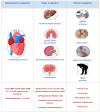The Congestion "Pandemic" in Acute Heart Failure Patients
- PMID: 38790913
- PMCID: PMC11117769
- DOI: 10.3390/biomedicines12050951
The Congestion "Pandemic" in Acute Heart Failure Patients
Abstract
Congestion not only represents a cardinal sign of heart failure (HF) but is also now recognized as the primary cause of hospital admissions, rehospitalization, and mortality among patients with acute heart failure (AHF). Congestion can manifest through various HF phenotypes in acute settings: volume overload, volume redistribution, or both. Recognizing the congestion phenotype is paramount, as it implies different therapeutic strategies for decongestion. Among patients with AHF, achieving complete decongestion is challenging, as more than half still experience residual congestion at discharge. Residual congestion is one of the strongest predictors of future cardiovascular events and poor outcomes. Through this review, we try to provide a better understanding of the congestion phenomenon among patients with AHF by highlighting insights into the pathophysiological mechanisms behind congestion and new diagnostic and management tools to achieve and maintain efficient decongestion.
Keywords: biomarkers; congestion; heart failure; volume overload; volume redistribution.
Conflict of interest statement
The authors declare no conflicts of interest.
Figures




References
-
- Mullens W., Damman K., Harjola V., Mebazaa A., Brunner-La Rocca H., Martens P., Testani J.M., Tang W.H.W., Orso F., Rossignol P., et al. The Use of Diuretics in Heart Failure with Congestion—A Position Statement from the Heart Failure Association of the European Society of Cardiology. Eur. J. Heart Fail. 2019;21:137–155. doi: 10.1002/ejhf.1369. - DOI - PubMed
Publication types
LinkOut - more resources
Full Text Sources
Research Materials
Miscellaneous

